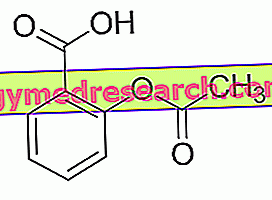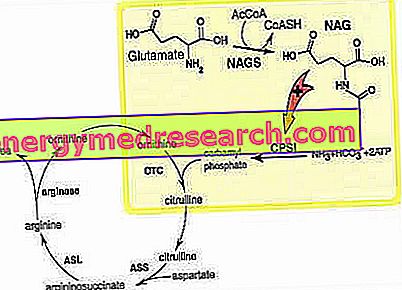Generality
Acetylsalicylic acid (or ASA) is a non-steroidal anti-inflammatory drug (NSAID) belonging to the salicylate family.
It is a drug with anti-inflammatory, analgesic and antipyretic activity. Furthermore - when used in small doses - acetylsalicylic acid has an anti-platelet aggregation action.

Acetylsalicylic acid - Chemical Structure
Acetylsalicylic acid is available in pharmaceutical formulations suitable for oral and parenteral administration.
Examples of medicinal specialties containing acetylsalicylic acid
- Ascriptin ®
- Alkaeffer ®
- Aspirin ®
- Aspirin C ® (in association with ascorbic acid).
- Aspirin Pain and Inflammation ®
- Aspirinetta ®
- Salicina ®
- Vivin C ® (in association with ascorbic acid).
Indications
For what it uses
The use of acetylsalicylic acid by mouth is indicated for the symptomatic treatment of:
- Headache;
- Toothache;
- neuralgia;
- Menstrual cramps;
- Rheumatic and muscular pains;
- Feverish states, flu and cooling syndromes.
When acetylsalicylic acid is used parenterally, it is used in the symptomatic treatment of:
- Inflammations of the musculoskeletal system;
- Neoplastic diseases;
- Post-traumatic pain;
- Post-operative pain.
Conversely, low dose oral acetylsalicylic acid is indicated for:
- Treatment of Kawasaki syndrome in children;
- Prevent the formation of blood clots so as to allow for:
- Prevention of major athero-thrombotic events;
- Prevention of reocclusion of aorto-coronary by-passes;
- Prevention of cardiovascular events in patients with atherosclerosis;
- Prevention of cardiovascular events in high-risk patients.
Warnings
Acetylsalicylic acid should not be taken in conjunction with other NSAIDs, so as to avoid the occurrence of dangerous side effects.
When using acetylsalicylic acid orally, the drug should be taken on a full stomach.
Concomitant intake of acetylsalicylic acid and alcohol causes an increased risk of developing gastrointestinal bleeding, therefore, this association should be avoided.
Acetylsalicylic acid may interfere with female fertility.
Patients who are on acetylsalicylic acid and need to have surgery of any size should inform their doctor as the drug may help bleeding.
Acetylsalicylic acid should be used with caution in patients with mild to moderate hepatic impairment, whereas it should not be used in patients with renal hypoperfusion, renal disease and / or heart failure.
Acetylsalicylic acid can cause bronchospasm crises in asthmatic patients and in predisposed individuals. For this reason, asthmatic patients should seek medical advice before taking the drug.
Even patients suffering from hyperuricemia or gout must seek the advice of their doctor before taking acetylsalicylic acid.
Finally, acetylsalicylic acid can cause undesirable effects that can alter the ability to drive and / or use machinery, so great care should be taken.
Interactions
Acetylsalicylic acid decreases the rate of elimination of methotrexate (an antitumor), thus increasing its toxicity, especially for the blood. Therefore, this association must be avoided.
Concomitant intake of acetylsalicylic acid and oral anticoagulants should be avoided, as there is an increased risk of bleeding.
Also, before starting the acetylsalicylic acid treatment, you need to tell your doctor if you are already taking any of the following medications:
- Other NSAIDs ;
- Antiplatelet agents ;
- Ibuprofen (a NSAID), since this drug is able to reduce the cardioprotective effects of acetylsalicylic acid;
- Cyclosporine, tacrolimus and other immunosuppressive drugs;
- Probenecid and other drugs used in the treatment of gout;
- SSRIs (selective serotonin reuptake inhibitors);
- Digoxin ;
- Anti-diabetics (such as, for example, sulfonylureas), since acetylsalicylic acid can increase the hypoglycemic effect of these drugs;
- Diuretics ;
- Corticosteroids ;
- Antihypertensive drugs;
- Phenytoin, an anti-epileptic.
In any case, it is a good idea to inform your doctor if you are taking any type of medication, including over-the-counter medicines and herbal and homeopathic products.
Side effects
Acetylsalicylic acid can cause several side effects, although not all patients experience them.
The type of side effects and the intensity with which they occur depend on each individual's sensitivity to the drug.
The main adverse effects that may occur during treatment with acetylsalicylic acid are listed below.
Blood and lymphatic system disorders
Acetylsalicylic acid therapy may cause:
- Prolongation of bleeding time;
- Anemia following gastrointestinal bleeding;
- Plateletopenia, ie the reduction in the number of platelets in the bloodstream.
Gastrointestinal disorders
Treatment with acetylsalicylic acid may cause:
- Gastrointestinal pain;
- Gastrointestinal ulceration, perforation and / or bleeding;
- Gastric disorders;
- Nausea and vomit;
- Hematemesis;
- Diarrhea;
- Melena;
- Esophagitis.
Skin and subcutaneous tissue disorders
Acetylsalicylic acid therapy may cause:
- Skin eruptions;
- Itch;
- Urticaria;
- Erythema.
Nervous system disorders
Dizziness, headache and dizziness may occur during treatment with acetylsalicylic acid.
Other side effects
Other side effects that may occur during acetylsalicylic acid therapy are:
- Allergic reactions, even serious, in sensitive individuals;
- Angioedema;
- Tinnitus;
- Reye syndrome;
- Asthmatic syndrome;
- Rhinitis;
- Nasal congestion;
- Conjunctivitis;
- Cardiorespiratory distress;
- Increased blood levels of liver transaminases;
- Changes in renal function;
- Perioperative bleeding;
- Purple;
- Local reactions at the injection site (when the drug is given parenterally).
Overdose
In case of moderate intoxication with acetylsalicylic acid, they can occur:
- Nausea and vomit;
- dizziness;
- Dizziness;
- Tinnitus;
- Hearing reduction;
- Headache;
- tachypnea;
- Respiratory alkalosis;
- hyperventilation;
- Confusional state.
Generally, these symptoms can be controlled by reducing the dosage of acetylsalicylic acid given.
In the event of severe poisoning, however, they can occur:
- Metabolic acidosis;
- Temperature;
- hyperventilation;
- Respiratory failure;
- Severe hypoglycemia;
- Cardiovascular collapse;
- Coma.
Severe intoxication can also have fatal outcomes.
For this reason, if you suspect you have taken excessive doses of acetylsalicylic acid, you must contact your doctor immediately and go to the nearest hospital.
Action mechanism
Acetylsalicylic acid exerts its anti-inflammatory, antipyretic, analgesic and anti-platelet aggregation action by inhibiting two particular isoforms of the cyclooxygenase enzyme: COX-1 and COX-2.
These enzymes have the job of converting arachidonic acid into prostaglandins, prostacyclines and thromboxanes.
COX-1 is a constitutive isoform, normally present in cells and involved in the mechanisms of cellular homeostasis. COX-1 is also present in platelets, within which it promotes the production of thromboxane A2, a substance responsible for platelet aggregation, therefore, also responsible for the formation of thrombi.
COX-2, on the other hand, is an inducible isoform that is produced by inflammatory cells (inflammatory cytokines) activated and promotes the synthesis of prostaglandins responsible for inflammation and pain (PGG2 and PGH2) and fever-inducing prostaglandins (PGE).
Through the inhibition of COX-2, therefore, acetylsalicylic acid hinders the production of the aforementioned prostaglandins by exerting its analgesic, anti-inflammatory and antipyretic action.
With the inhibition of COX-1 present in platelets, on the other hand, acetylsalicylic acid prevents the formation of thromboxane A2, thus performing an anti-platelet aggregation action.
Mode of Use - Posology
As mentioned, acetylsalicylic acid is available for oral administration (in the form of tablets, soft capsules and powder for oral solution) and for parenteral administration (in the form of powder and solvent for solution for injection).
During treatment with the drug, it is necessary to follow the instructions provided by the doctor, both in terms of the amount of acetylsalicylic acid to be taken and in terms of the duration of the treatment itself.
Below are some indications on the doses of acetylsalicylic acid usually used in therapy.
Elderly patients may need a reduction in the doses of medication usually used.
Oral administration
Salicylic acid administered orally can be used to treat painful conditions of a different nature, to treat Kawasaki syndrome in children and to prevent blood clots from forming.
For the treatment of painful states of different nature, the dose of acetylsalicylic acid usually used can range from 325 mg to 1000 mg, to be taken 2-3 times a day.
For the prevention of blood clots, the usual acetylsalicylic acid dose is 75-100 mg per day.
For the treatment of Kawasaki syndrome in children, however, the dose of acetylsalicylic acid usually administered is 80-100 mg / kg of body weight for the first 14 days of therapy. Subsequently, the dose is reduced to 3-5 mg / kg of body weight for another 6-8 weeks. In any case, it is essential to follow the instructions given by the doctor.
Parenteral administration
In this case, the dose of acetylsalicylic acid usually used is 500-1000 mg to be administered every 6, 8 or 12 hours intravenously or intramuscularly. The amount of drug to be taken and the frequency of administration depend on the severity of the pain presented by the patients.
Pregnancy and breastfeeding
During the first and second trimester of pregnancy, acetylsalicylic acid can only be used if the doctor considers it absolutely necessary.
In the third trimester of pregnancy, however, the use of acetylsalicylic acid is contraindicated, due to the damage that the drug can cause to the fetus and the mother.
Furthermore, since acetylsalicylic acid is excreted in breast milk, its use is also contraindicated in breastfeeding mothers.
Contraindications
The use of acetylsalicylic acid is contraindicated in the following cases:
- In patients with known hypersensitivity to the extended acetylsalicylic acid, to analgesic-antipyretics and / or to other NSAIDs;
- In patients who have experienced asthma after taking other salicylates or other NSAIDs;
- In patients with gastrointestinal ulcer;
- In patients suffering from severe cardiac, hepatic and / or renal insufficiency;
- In patients with predisposition to the development of hemorrhages;
- In patients with a deficiency of the enzyme glucose-6-phosphate dehydrogenase;
- In patients already on methotrexate therapy or with oral anticoagulants;
- In patients with mastocytosis;
- In children and adolescents less than 16 years of age (except when the drug is used at a low dose for the treatment of Kawasaki syndrome in children);
- In the last trimester of pregnancy;
- During breastfeeding.



